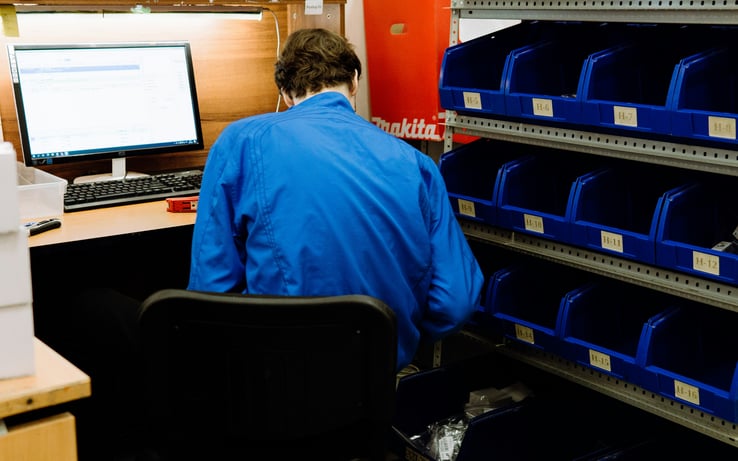People who have chosen and been approved for self-directed services, have the ability to live independently, choose the caregivers they want, and direct how their care is delivered. This autonomy comes with dignity, respect, but also significant operational, compliance, and equity challenges working with the assessors (from Medicaid or the VA) and for working with Financial Management Services (FMS) providers (sometimes called Fiscal Agents).
According to the Centers for Medicaid and Medicare Services (CMS) and new research from UnitedHealthcare, more than 57% of Medicaid long-term services and supports (LTSS) spending is going toward home- and community-based services (HCBS).
However, the self-direction trends remain uneven, due to administrative hurdles, educational barriers, and systems limitations. Let's breakdown five of the biggest challenges to the delivery of self-directed care that we are addressing with Ankota's FMS software solutions.
Quick note about your author (Ankota): Our goal is to make your interaction with your FMS be easy and pleasurable. We've built applications for the fiscal agents themselves to better manage your services, but we've also built an app for self-directed participants to track budgets, submit and approve expenses, and for your service providers/employees to comply with EVV.
1. Administrative Complications and Staff Burnout
❌ Challenge: Many FMS providers manually record their caregiver time sheets, process payroll, onboard caregivers, and submit democratically-approved Medicaid claims while trying to stay within evolving state requirements.
✅ Solution: With Ankota’s self-direction financial management software, individual financial management techniques and systems, such as timesheets, onboarding caregivers, and Medicaid compliant bill, are no longer siloed systems. Instead, they all work together in one solution to ease administrative complexity and staff burnout.
"Independent living and self-direction are often misconstrued, creating a risk to regulator or provider actions that may alter a person's experience." — UnitedHealthcare, 2021

2. The EVV Implementation and Compliance Gap
❌ Problem: Electronic Visit Verification (EVV) is required, but states have different ways to implement it, making it time-consuming for providers to ensure compliance. Many existing tools are cumbersome for caregivers to use, which creates friction and risk.
✅ Solution: Ankota's EVV is fully integrated within the application, and designed specifically for participant-directed models. It is useable on any mobile device and easy to understand as a digital layperson, reducing complexity for caregivers, and keeping providers compliance-ready.

3. Limited Visibility into Budgets and Billing
❌ Challenge as to when budget overruns may occur is when participants don't have real-time budget visibility and they overspend without knowledge of their budget and when FMS providers are trying to comply with obligations for bill documentation when claims get denied, or with audits where they cannot demonstrate a complete billing record and audit trail.
✅ Solution: With Ankota's platform, an organization has real-time (and historical) oversight of budgets, configurable budget and budget overrun alerts for anyone needing or tracking them, Medicaid-ready reimbursement workflows, and a straightforward and easy to go manage the spending of the service which means an organization will improve audits and have fewer denied claims.
4. Inequity in Awareness and Access
❌ Challenge: There are many who qualify for self-direction that do not know it exists—or they don't know where to start. Others may simply not have access to a caregiver network or even find themselves buried in an overwhelming Medicaid application process. We know these gaps tend to disproportionately affect people of color and those living in rural areas.
✅ Solution: Ankota is helping close the equity gap by enabling family caregivers to onboard or sign-up quickly to help the participant to have some autonomy (by completing their own service with limited help). Additionally, State and Managed Care Organizations (MCOs) can use Ankota to streamline the access way to provide a defined process of access and assisting with outreach in a definitive way.
📱 For instance, Ankota’s mobile friendly design makes it easy for participants and caregivers to view approved hours and track their schedules (for example caregivers may document care). The accompanying screenshots provide some evidence of how friendly/usable Ankota is: Users can see real-time access to service hours, download records, and review the care calendar with little effort. Ankota provides the application in the users preferred language and supports community who may not be English-language speakers by lowering their barriers to access.
These small, yet impactful design decisions provide essential value to help reach and include communities that have been left out and empowered participants who would be excluded with the barriers of digital or literacy deprivation.
5. Workforce Crisis and Onboarding Barriers
❌ Challenge: The U.S. is currently grappling with a direct care workforce crisis. Palco states that not supporting self-direction drives this crisis deeper, as caregivers prefer flexible, participant-centered work, but face barriers with cumbersome bureaucratic rules, training, and paperwork.
✅ Solution: Ankota speeds up onboarding participant-directed caregivers by automating background checks, tax forms and other credential tracking for the caregiver. This enables caregivers, especially those who are the relatives or trusted community members of the participant, to start sooner with reduced barriers to entry.

A Smarter Way to Support Self-Direction
Medicaid’s self-direction programs are at a turning point. They offer a scalable solution to rising LTSS needs, workforce shortages, and growing consumer demand for autonomy. But they require modern infrastructure to function at scale.
With Ankota, states and providers get:

✔ Audit-ready compliance tools
✔ Medicaid-optimized billing and payroll
✔ EVV that actually works for caregivers
✔ Real-time budget visibility
✔ Empowered, human-centered service delivery
👉 Ready to Transform Your FMS Operations?
Let’s work together to reduce risk, boost satisfaction, and grow your self-direction programs—without adding administrative burden.
Ankota's mission is to enable the Heroes who keep older and disabled people living at home to focus on care because we take care of the tech. If you need software for home care, EVV, I/DD Services, Self-Direction FMS, Adult Day Care centers, or Caregiver Recruiting, please Contact Ankota.


-png.png?width=243&height=537&name=EVV%20Software%20Korean%20(3)-png.png)
-png.png?width=2000&height=933&name=Ankota%20-%20demo%20(1)-png.png)


Your Comments :